


ORGANS OF PARIS © 2024 Vincent Hildebrandt HOME ALL ORGANS

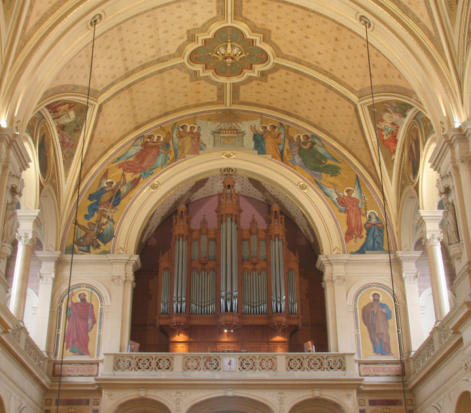

Ste Trinité was built in 1861-1867 by Théodore Ballu. It
is a rather personal mix of French and Italian gothic
and renaissance styles.
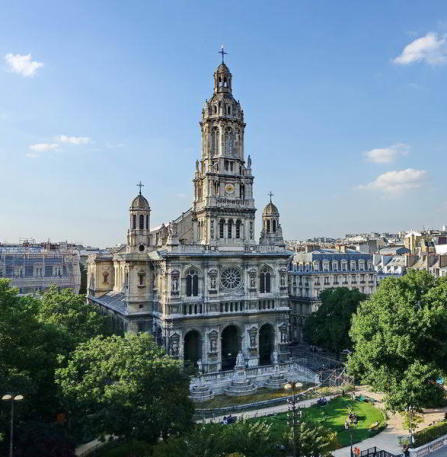

C3
The great organ is one of Cavaillé-Coll's major works.
Commissioned in 1864, it was inaugurated in 1869 by
Camille Saint-Saëns, César Franck, Alexis Chauvet (the first
titulaire), Henri Fissot and Charles-Marie Widor.
The instrument. being considerably deteriorated during
the events of the Commune, was completely rebuilt in
1871 by Cavaillé-Coll. The organ had 46 stops on 3
keyboards and pedalboard. Apart from the replacement of
the Doublette 2' by the Quinte 2 2/3', the organ will remain
so until 1901.
In 1901, Mutin or Merklin made several modifications.
In 1934-1935, a major restoration was carried out by
Pleyel-Cavaillé-Coll including a complete restoration of the
mechanics, the dusting of the pipes, the reharmonization
of old stops, the addition of seven new stops (POS:
Principal 8', Cor de nuit 8', Nasard 2 2/3', Tierce 1 3/5; REC:
Bourdon 16', Nasard 2 2/3, Cymbale III), the addition of two
combination pedals (introduction of the Pedal, low octave
on the Great Organ), removal of the 4' Flutes from the reed
windchest and their installation on that of the foundation
stops and the addition of Barker levers to the Positive.
The organ now has 53 stops.
Between 1962-1967, Beuchet-Debierre carried out a third
restoration and enlargement. The program of work
included the complete electrification of the organ, the
installation of a new console (the old one was dismantled
and destroyed) as well as additional upper boards to the
GO and Positive, appearance of a combinator with
adjustable combinations, appearance of an expressive box
to the Positive for the Cornet (decomposed) + Piccolo and
Clarinet, and finally addition of 7 stops: POS: Clairon 4',
Flageolet 2', Fourniture IV; REC: Bombarde 16', Tierce 1
3/5'; GO: Cymbale IV; PED: Plein Jeu IV.
According to correspondence between Messiaen and
Eugène Picaud (one of Beuchet's employees), Messiaen
insisted that the stamps of Cavaillé-Coll remain unchanged.
The organ now has 60 stops.
In 1984, Sebire& Glandaz carried out some work. Olivier
Messiaen asks that some background stops have a greater
sound presence by increasing the intensity gradually
towards the treble. Some reeds will also be increased in
intensity and strength. Some teeth are reduced so that the
whole is less "gambé" and that the attack of the notes is
particularly clear and that the harmonization gives each
stop a very specific luminosity. The highest pipes of the
Piccolo are replaced by pipes of larger size.
In 1992 and 1993, the same house carried out a complete
overhaul of the organ. Olivier Messiaen wants the Cymbal
of the Great Organ to be reduced. At his request, the
fourth row is blocked on the entire extent of the keyboard
except the last five notes and the third rank is also blocked
on the large expanse of the keyboard (ut1 – sol3). In
addition, the work includes:
•all pipes are removed, overhauled, cleaned and repaired;
•console rewiring;
•Review of notes and stop controls;
•thorough cleaning;
•harmonization and general tuning.
In 2004, Olivier GLANDAZ revised the organ.
1869 - Cavaillé-Coll (1)
1901 - Mutin ou Merklin (5)
1934 - Pleyel-Cavaille-Coll (3a)
1967 - Beuchet-Debierre (3a)
1984 - Sebire & Glandaz (6)
1993 - Sebire & Glandaz (5)
2004 - Glandaz (6)
III/61 - traction électrique
composition
Organiste titulaire
Thomas Lacôte (titulaire), Jean-François Hatton
(titulaire adjoint), Loïc Mallié (titulaire honoraire)
Famous organists in the past : Charles-Alexis Chauvet,
Alexandre Guilmant, Olivier Messiaen, Naji Hakim
Concerts
Regularly
Masses with organ
Sundag 11:00 AM
Videos
Thomas Lacôte
Karol Mossakowski
photo buffet : Jeroen de Haan
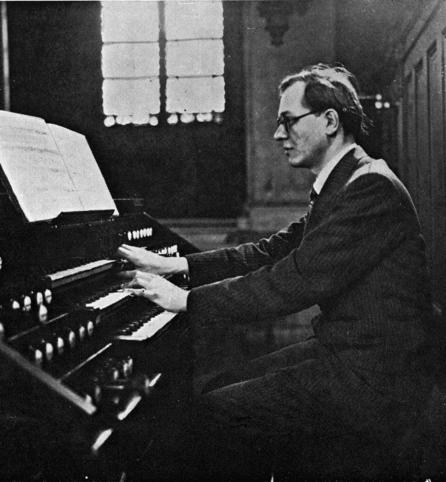
Olivier Messiaen à l’orgue (environ 1940)
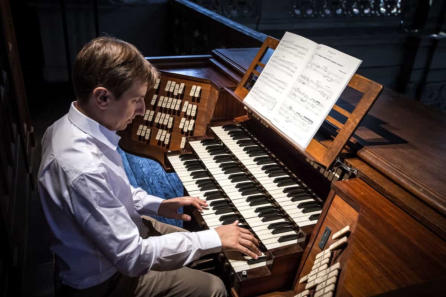
Thomas Lacôte à l’orgue
The organs of Paris
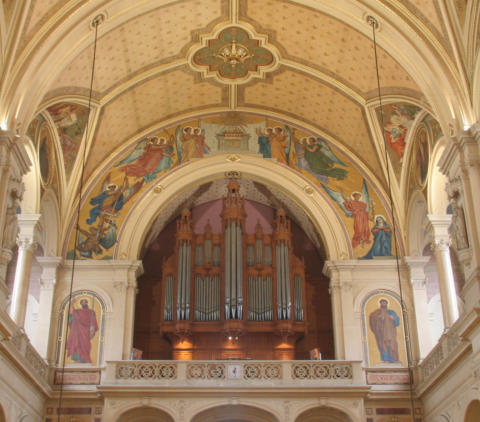
ORGANS OF PARIS © 2024 Vincent Hildebrandt ALL ORGANS
1869 - Cavaillé-Coll (1)
1901 - Mutin ou Merklin (5)
1934 - Pleyel-Cavaille-Coll (3a)
1967 - Beuchet-Debierre (3a)
1984 - Sebire & Glandaz (6)
1993 - Sebire & Glandaz (5)
2004 - Glandaz (6)
III/61 - traction électrique
composition
Organiste titulaire
Thomas Lacôte (titulaire), Jean-François Hatton
(titulaire adjoint), Loïc Mallié (titulaire honoraire)
Famous organists in the past : Charles-Alexis Chauvet,
Alexandre Guilmant, Olivier Messiaen, Naji Hakim
Concerts
Regularly
Masses with organ
Sundag 11:00 AM
Videos
Thomas Lacôte
Karol Mossakowski
photo buffet : Jeroen de Haan
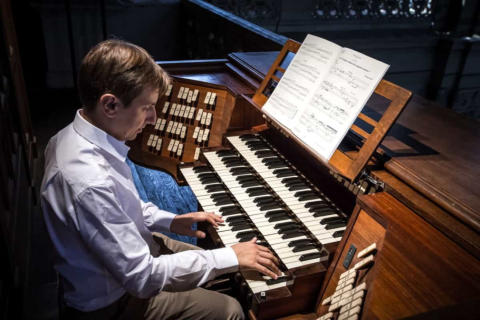
Thomas Lacôte à l’orgue
C3
The great organ is one of Cavaillé-Coll's major works.
Commissioned in 1864, it was inaugurated in 1869 by Camille
Saint-Saëns, César Franck, Alexis Chauvet (the first titulaire),
Henri Fissot and Charles-Marie Widor.
The instrument. being considerably deteriorated during the
events of the Commune, was completely rebuilt in 1871 by
Cavaillé-Coll. The organ had 46 stops on 3 keyboards and
pedalboard. Apart from the replacement of the Doublette 2'
by the Quinte 2 2/3', the organ will remain so until 1901.
In 1901, Mutin or Merklin made several modifications.
In 1934-1935, a major restoration was carried out by Pleyel-
Cavaillé-Coll including a complete restoration of the
mechanics, the dusting of the pipes, the reharmonization of
old stops, the addition of seven new stops (POS: Principal 8',
Cor de nuit 8', Nasard 2 2/3', Tierce 1 3/5; REC: Bourdon 16',
Nasard 2 2/3, Cymbale III), the addition of two combination
pedals (introduction of the Pedal, low octave on the Great
Organ), removal of the 4' Flutes from the reed windchest and
their installation on that of the foundation stops and the
addition of Barker levers to the Positive.
The organ now has 53 stops.
Between 1962-1967, Beuchet-Debierre carried out a third
restoration and enlargement. The program of work included
the complete electrification of the organ, the installation of a
new console (the old one was dismantled and destroyed) as
well as additional upper boards to the GO and Positive,
appearance of a combinator with adjustable combinations,
appearance of an expressive box to the Positive for the
Cornet (decomposed) + Piccolo and Clarinet, and finally
addition of 7 stops: POS: Clairon 4', Flageolet 2', Fourniture
IV; REC: Bombarde 16', Tierce 1 3/5'; GO: Cymbale IV; PED:
Plein Jeu IV.
According to correspondence between Messiaen and Eugène
Picaud (one of Beuchet's employees), Messiaen insisted that
the stamps of Cavaillé-Coll remain unchanged.
The organ now has 60 stops.
In 1984, Sebire& Glandaz carried out some work. Olivier
Messiaen asks that some background stops have a greater
sound presence by increasing the intensity gradually towards
the treble. Some reeds will also be increased in intensity and
strength. Some teeth are reduced so that the whole is less
"gambé" and that the attack of the notes is particularly clear
and that the harmonization gives each stop a very specific
luminosity. The highest pipes of the Piccolo are replaced by
pipes of larger size.
In 1992 and 1993, the same house carried out a complete
overhaul of the organ. Olivier Messiaen wants the Cymbal of
the Great Organ to be reduced. At his request, the fourth row
is blocked on the entire extent of the keyboard except the
last five notes and the third rank is also blocked on the large
expanse of the keyboard (ut1 – sol3). In addition, the work
includes:
•all pipes are removed, overhauled, cleaned and repaired;
•console rewiring;
•Review of notes and stop controls;
•thorough cleaning;
•harmonization and general tuning.
In 2004, Olivier GLANDAZ revised the organ.






















